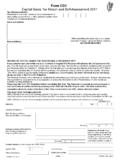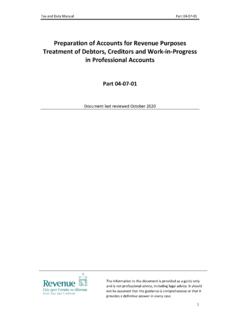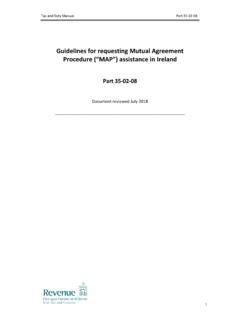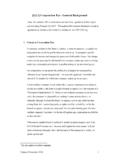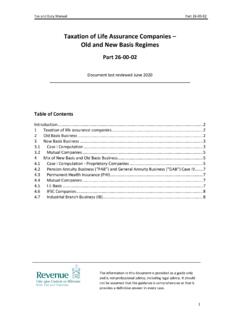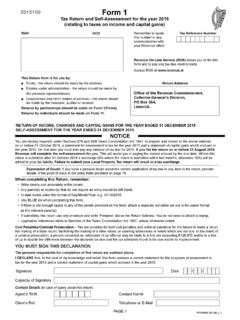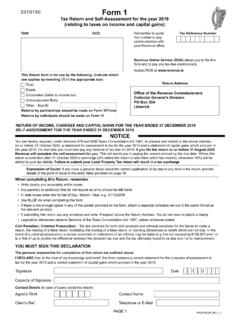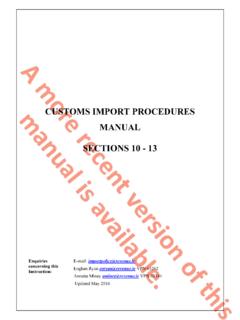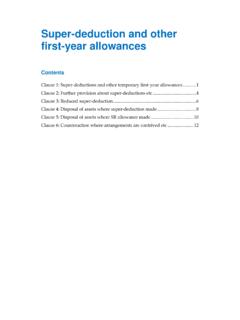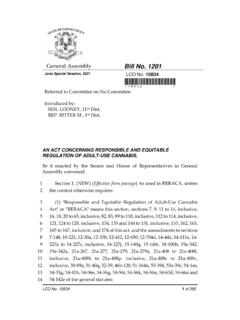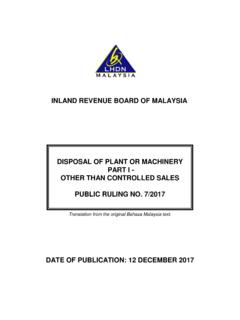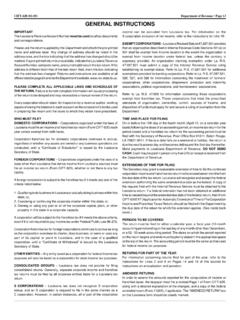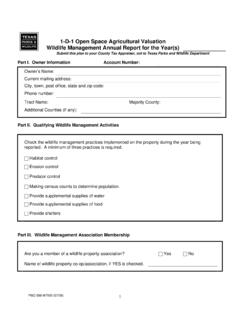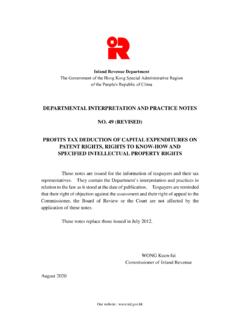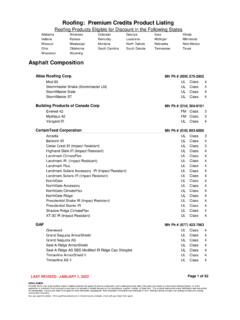Transcription of Research and Development (R&D) Tax Credit - Revenue
1 Tax and Duty ManualPart 29-02-03 The information in this document is provided as a guide only and is not professional advice, including legal advice. It should not be assumed that the guidance is comprehensive or that it provides a definitive answer in every and Development (R&D) Tax CreditPart 29-02-03 This document should be read in conjunction with section 766, 766A, 766B, and 766C of the Taxes Consolidation Act 1997 Document last updated December 2021 Tax and Duty ManualPart 29-02-032 Table of requirements for year the on amount of payable to treat grants Science Test in micro or small enterprises which are supported by R&D with IDA/Enterprise Ireland s/Horizon 2020 R&D to limit on claims and time frames for payable of Research and Development .
2 Investigative or Experimental of Science & of or Technological or Technological materials / products / Activity pertaining to or Failure of R&D undertaken by the claimant / Staff used in R&D Activities which may be subsequently and Duty ManualPart carried on as part of an Existing and Structures used for Research & a building / structure is sold, or ceases to be used for R& and R&D R&D is sub-contracted out, when is the Credit allowable?.. Expenditure on R& on group group expenditure on R& qualifying group expenditure on R&D with threshold of group expenditure between group of R&D activity within a to Group of an R&D for a valid Science Accounting aided R&D accounting of Record Industry the to to Key Employees.
3 With other persons (Independent experts).. Regime for Small and Micro 1 Categories of Activities which may qualify for the R&D 2 Categories of Activity that are not Research and Development 3 R&D Tax Credit Claim, Suggested File 4 Schedule of and Duty ManualPart Consolidation Act (TCA) 766, 766A and 766B of the Taxes Consolidation Act (TCA) 1997 (the Act) and the Taxes Consolidation Act (Prescribed Research and Development Activities Regulations) 2004 ( No. 434/2004) provide for a tax Credit for certain expenditure on Research and Development (R&D) activities, plant and machinery and buildings.
4 Credit is given at 25% of allowable expenditure. For accounting periods commencing prior to 1/1/2015 the amount of qualifying expenditure is restricted to incremental expenditure over expenditure in a base year (2003) defined as the threshold amount . The Finance Act of 2012 introduced an allowable amount to be excluded from the incremental basis of calculation. This allowed the first 100,000 of qualifying R&D expenditure to qualify for the Credit , regardless of the base year (2003) expenditure. This amount was increased for 2013 and Prior to 2012, the qualifying R&D expenditure was reduced in full by the base-year expenditure in calculating the relief.
5 For accounting periods beginning on or after 1 January 2015, the requirement to subtract base-year (2003) R&D expenditure was removed and all qualifying R&D expenditure is eligible for the 25% tax 1 Section 766(1)(a) TCA 1997 in the definition of qualifying group expenditure on Research and Development .2 Section 766(1)(a) TCA 1997 in the definition of qualifying group expenditure on Research and Development , as amended by Finance Act and Duty ManualPart requirements for qualification3To qualify for the Credit , the following must apply: the applicant must be a the company must be within the charge to Irish tax.
6 The company must undertake qualifying R&D activities within the European Economic Area (EEA) or the UK. in the case of an Irish tax resident company, the expenditure must not qualify for a tax deduction under the law of another territory. qualifying activities must satisfy all of the following conditions5. They must systematic, investigative or experimental activities; in a field of science or technology; one or more of the following categories of R&D Research , Research , addition, they to achieve scientific or technological advancement; the resolution of scientific or technological tax Credit is calculated separately from the normal deduction of the R&D expenditure in computing the taxable profits of the company6.
7 Companies claiming the R&D tax Credit are not required to hold the intellectual property rights resulting from the R&D work. Equally, there is no requirement for the R&D work to be successful. The definition of qualifying R&D activity requires that a claimant company engage in systematic activity which seeks to achieve a scientific or technological advancement, and which involves the resolution of scientific or technological claims for R&D tax Credit (under ) must be made within 12 months from the end of the accounting period in which the expenditure was incurred.
8 Expenditure on buildings and structures to be used for R&D ( ), must be made within 12 months from the end of the accounting period in which the relevant expenditure was incurred (for more detail see Part 5 of these Guidelines.)3 Section 766(1)(a) TCA 1997 in the definition of qualified company .4 Section 766 generally provides rules relating to groups of companies but provides that where a company is not part of a group the company shall be treated as a group comprising that one company. For ease of reading the singular term company is used throughout these guidelines.
9 See also Section 7 of these Guidelines for further information with regard to Section 766(1)(a) TCA 1997 in the definition of Research and Development activities .6 Where the relevant accounting standard allows the company to recognise the value of the R&D Credit in its financial statements any amount so included in the calculation of accounting profit/loss may be deducted in the calculation of taxable and Duty ManualPart year requirement7 The R&D tax Credit was originally designed to incentivise incremental R&D expenditure. 2003 was set as the base year for all accounting periods.
10 This meant that if a company incurred expenditure on R&D in 2003 the amount of that expenditure was to be subtracted from the current year expenditure when calculating a claim. This 2003 amount is referred to as the threshold amount . From 2012 the formula to calculate the qualifying expenditure was amended to allow an amount to qualify for the R&D tax Credit irrespective of 2003 expenditure see table below. The Finance Act 2014 removed the requirement to subtract base year expenditure in calculating claims for accounting periods commencing on or after 1 January PeriodBase year restrictionUp to and including 31 December 2011 Full base year (2003) expenditure (known as threshold amount )

